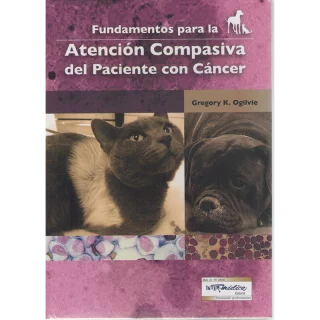Envío gratuito en compras superiores a 19€ (Península y Baleares)
This Guide to Oncology for Veterinary Clinicians compiles practical information to aid veterinary clinicians in managing cancer patients, and covers aspects related to diagnosis, prognosis, and treatment, as well as pain management and communication with owners. It has been developed by leading specialists in oncology who approach the subject from a practical perspective, and includes many images, tables, and diagrams that facilitate understanding of its content and make it an essential volume on the bookshelves of any veterinary clinic.
1. Dealing with a patient with a mass: client communication
Introduction
Breaking the news and dealing with the consequences
Dispelling fears and myths
Staff training
Losing a pet
Quality of life
Compassion fatigue
2. Recognising signs consistent with cancer in senior pets
Signs of oral cancer
Signs of skin cancer
Cats
Dogs
Signs of abdominal tumours
Cats
Dogs
Other signs of cancer
Age-related changes in different body systems
Diagnosis and prognosis in veterinaryoncology
3. Diagnostic procedures in veterinary oncology
Cytology
Introduction
Sample collection, slide preparation, and staining
Cell interpretation protocol
Biopsy
Blood and bone marrow smears
Flow cytometry and PCR for antigen receptor rearrangements
The importance of immunophenotyping in canine lymphoma
Flow cytometry
PCR for antigen receptor rearrangements
Diagnostic imaging in veterinary oncology
Radiography
Ultrasound
Computed tomography
Magnetic resonance imaging
Endoscopy
Gastrointestinal endoscopy
Airway endoscopy
Endoscopy in other locations
General state of senior patients.
Laboratory tests
Clinical staging:
TNM staging system
4. Diagnostic interpretation, choice of treatment, and prognosis
Cytology
Cytological assessment of cell lineage
Assessment of cytological criteria for malignancy
Cytological characteristics of main tumours
Biopsy
What is tumour grade?
Tumour margins
Special stains
Biological behaviour of tumours according to tissue of origin
Epithelial tumours
Mesenchymal tumours
Haematopoietic tumours
Other origins
Biological behaviour of tumours according to location
Cutaneous and subcutaneous tumours
Head, neck, and ear tumours
Chest cavity tumours
Tumours of the reproductive system
Abdominal cavity tumours
Nervous system tumours
Skeletal tumours
Haematopoietic tumours
5. Cancer treatment
Surgery
Introduction
Indications
Chemotherapy
Indications
Resistance
Handling of cytostatics
Classification of anticancer drugs
Adverse effects of chemotherapy
Radiation therapy
Principles of radiobiology
Equipment
Indications
Adverse effects
Antiangiogenic therapy
Tyrosine kinase inhibitors
Biology
Kinase inhibition
Immunotherapy
Biological response modifiers
Recombinant cytokines
Antitumour vaccines
COX-2 inhibitors
6. Pain in veterinary oncology
Evaluating pain in a patient with cancer
Signs of pain
Pain treatment
Why treat and when?
Classification of analgesics
New analgesic techniques
Analgesic treatment during oncological surgery
7. Appendices
Appendix I. Paraneoplastic syndromes
Haematological disorders
Metabolic, digestive, and endocrine-related disorders
Cutaneous disorders
Other
Appendix II. Treatment protocols
Canine lymphoma
Feline lymphoma
Canine haemangiosarcoma/
Soft tissue sarcoma
Multiple myeloma
Canine mast cell tumour
Carcinomas in dogs
Carcinomas and sarcomas in cats
Osteosarcoma in dogs
Appendix III. Metronomic therapy
Appendix IV. Survival data for nervous system tumours
8. References
- Autor/es Noemí del Castillo Magán, Ricardo Ruano Barneda
- Fecha de edición junio 2018
- Nº Páginas 192
- Encuadernación Tapa dura
- Tamaño 22 X 28
- Idioma Inglés












